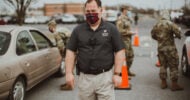It was a quarter past six in the evening. The day team had just completed their signout to us. As we sat quietly along the periphery of the trauma bay getting oriented to our list of patients, a small army of hospital personnel started trickling in. We were expecting company.
He was rolled into the first slot. From behind the desk, I tried assessing how serious the injuries were, but the crowd obstructed my view of the patient. Eager to help, I put on a pair of gloves and approached the stretcher. It was a mess of joints sprouting out of awkward angles and blood painting abstract images across his body. As the primary survey was conducted, I watched the organized chaos unfold from the sidelines.
When the team leader called for a secondary survey, I stepped up to help roll the patient. I had a front row view of at a mangled extremity and blood soaked sheets. After the spine and rectal tone was cleared, we gently laid him back down. Meanwhile, supplies were being gathered for intubation. In his confused state, he kept trying to sit up and move his dislocated upper extremity. I reflexively held his arm down in an attempt to stabilize the field for airway access.
His eyes turned toward me as he asked, “Can I get up now?”
I shook my head as I responded, “No sir, we’re trying to help you. You need to relax.”
As his arm relaxed, his eyes remained transfixed on mine. I continued, “You’re doing great.”
Suddenly, his head flexed up and his arm resisted mine. Blood spattered everywhere as we tried to control his movements.
I tried again, “Sir, you need to keep your head down. We’re trying to help.”
His eyes drifted toward my voice again as he replied, “Can I get up now?” I shook my head in response and felt the tension from his arm fade away. His eyelids drifted downward as the endotracheal tube was placed.
Hours later, we were called to his bedside. Although he had been primarily stable, his vitals dipped in and out of tumultuous waters. Our team was there to place additional invasive lines. As the area was prepped and draped, his hand kept grabbing at the resident. She motioned toward me and I grabbed his hand to keep it from distracting her. His fingers closed tightly around mine.
The area was prepped and my arm covered by a sterile drape. Underneath the blue barrier, his grip was strong, but frigid. I squeezed for reassurance. His eyes moved to meet mine; they looked confused and frightened. I checked the monitors for his vitals – stable. Suddenly, he started shivering in response to the hypovolemic state. I asked for warm blankets and bundled his exposed body. As more sedatives were pumped into his IV, his hold slowly loosened.
Since starting clerkships, I have often felt like a fly — curiously buzzing around and always in the way. Prior to this experience, I firmly believed that medical student rotations offer the illusion of contributing to the healthcare team and rare moments to truly assist. The reality is that in an effort to advance our medical knowledge, we can hinder or delay healthcare. But as I held this man’s icy hand, my paradigm shifted; in this moment, I was a buoy keeping him afloat.
Two weeks later, I went up to his room. I had been following his recovery through his electronic medical record, but wanted the opportunity to speak with him. I peeked my head from behind the curtain and I saw a man deep in thought. He was sitting up in a chair covered with bandages. Healed lacerations peeked out from under his gown.
“Hello, sir,” I said as I walked toward him. “I’m Amanda, one of the medical students in the trauma bay when you were brought in.” His eyes lit up as they met mine. He then held out his hand. I reached out to be greeted by a grasp that was familiar and warm.
Amanda Xi is a medical student who blogs at And Thus, It Begins and can be reached on Twitter @amandasxi.














![Preventing physician burnout before it begins in med school [PODCAST]](https://kevinmd.com/wp-content/uploads/The-Podcast-by-KevinMD-WideScreen-3000-px-4-190x100.jpg)


![Why high-quality embryos sometimes fail to implant [PODCAST]](https://kevinmd.com/wp-content/uploads/Design-3-190x100.jpg)

